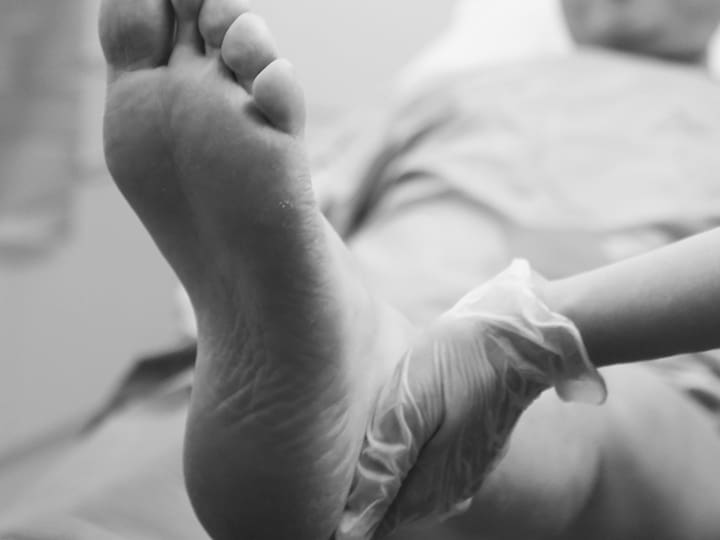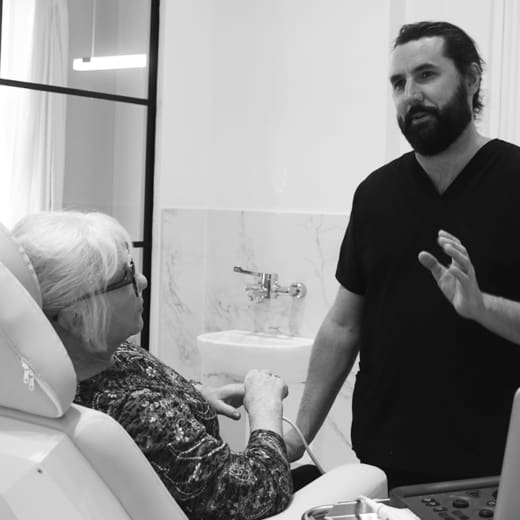McKeown Medical
167 Bath Street, Glasgow, G2 4SQ
Date posted — 18.07.25

Varicose veins affect around 20% of the population in Scotland, yet many people are unaware of the early signs or may mistake them for something less serious. Symptoms often start subtly, such as aching legs, mild swelling, or changes in skin texture, which can easily be dismissed as normal ageing or tiredness. However, varicose veins are progressive, meaning they tend to worsen over time if left untreated. The good news? Early intervention can make a dramatic difference, not just cosmetically, but in how your legs feel and function.
At McKeown Medical, we believe that educating people early about the signs of varicose veins can help reduce complications, improve quality of life, and make treatment more straightforward. If you’ve ever wondered what to watch for, here’s what you need to know.
To understand varicose veins, it is helpful to start with how the veins in your legs function. The venous system carries deoxygenated blood back to your heart. In the legs, blood must flow upwards against gravity, and this is made possible by a series of one-way valves inside the veins that keep blood flowing in the right direction.
When these valves become weakened or damaged, blood can pool in the lower veins, causing them to become enlarged, twisted, and bulging—what we recognise as varicose veins.
Common misconceptions:
Here are the signs to look out for in the early stages, even before veins become obviously visible:
A common early symptom. Your legs may feel heavy or tired, especially after standing or sitting for long periods. It’s often worse at the end of the day.
You might notice a dull ache or throbbing sensation in your legs. This may be more noticeable during hot weather or after physical activity.
Mild swelling around the ankles or lower legs may come and go, often mistaken for fluid retention or standing too long.
Look for dryness, itchiness, or a mild brown discolouration of the skin. Over time, untreated varicose veins can cause eczema-like changes or even hardening of the skin (lipodermatosclerosis).
Early varicose veins may appear as thin, blue or purple lines beneath the skin before they bulge. Don’t ignore these subtle signs.
Many people describe a strong urge to move their legs at night or experience nighttime cramps, often one of the first clues that something is wrong with the venous circulation.
You may feel a burning or tingling sensation in the lower legs, which may be confused with nerve issues or simple fatigue.
These symptoms often worsen with prolonged standing and improve with elevation, a key distinction from other causes of leg discomfort. Most varicose veins occur in the lower legs, but they can also affect the thighs, ankles, or feet.
While anyone can develop varicose veins, some people are more prone than others. Having risk factors doesn’t guarantee you’ll develop the condition, but it does increase the likelihood, especially if multiple factors apply.
Non-modifiable risk factors:
Modifiable risk factors:
If you’re in a high-risk group, early screening and lifestyle changes can help delay or prevent symptoms altogether.
If you’re noticing any of the signs above, or if you’re in a high-risk group and want peace of mind, it’s worth booking a consultation. Many people wait until symptoms become severe, but earlier assessment often means simpler, less invasive treatment options.
At McKeown Medical, we offer a wide range of modern treatments, including:
Varicose veins are common, but they don’t need to be permanent. Catching the early signs can make a significant difference—not only in how your legs look but also in how they feel. With modern, minimally invasive treatment options, managing varicose veins has never been easier.
At McKeown Medical, we offer the latest diagnostic tools and treatment options tailored to your needs. Whether you’re noticing the first signs or want to be proactive, our team is here to help you feel confident and comfortable again.
Varicose veins are common, but can easily be treated. At McKeown Medical, we have a wide range of treatment options available that can help combat this issue. Discuss which treatment may be best for you and book a consultation with our team today.

Varicose veins are enlarged, twisted veins that often appear just under the skin, primarily in the legs and feet.
1 / 3
2 / 3
3 / 3

Varicose veins are enlarged, twisted veins that often appear just under the skin, primarily in the legs and feet.
We’ve been in our new home for a year now and I thought this would be a good time to remind you just how special it is with a little video tour.
It’s been a remarkable year for us in our new home; we’ve introduced new doctors, new treatments, new services and our team continues to grow from strength to strength - always striving to provide more and better for our wonderful patients.
Enjoy the tour!

About last night… It was time once again for our annual Christmas celebration with this absolute bunch of legends. We were a little earlier than usual this year so we could have has many people available as possible, and the evening did not disappoint.
A few sore heads this morning, but absolutely worth it to celebrate the hard work this team dedicate to our patients day in, day out all year round. I am very proud to have the undisputed best team on the planet. Merry Christmas everyone! 🎄

Fine lines etched into the skin around the mouth - this is a common problem and in this patient`s case she had what we call ‘actinic elastosis’, whereby abnormal bands of elastin build up in the skin as a result of years of previous sun exposure.
When patients have this condition, the gold standard way of dealing with it is fully ablative laser resurfacing. It’s an intense treatment with two weeks of downtime afterwards, but the results are spectacular - just like in this lovely patient.
The after photo is three weeks after the treatment and you can see that the skin is still a little pink, which will continue to fade over the next few months.
The patient is already delighted with the result - what do you think?

It’s beginning to look a lot like Christmas!
At least according to Michael Buble, who’s been on repeat in the clinic this week. The decorations are up and we are officially in ‘our season’. The clinic has been packed with everyone having their skin polished in time to make it on the nice list. If you’ve still to make a pre-Christmas appointment, we’ve still got some spaces left for your festive glow up.
Ho ho ho everyone… It’s time for Santa!!!! 🎅🏻

Ok, so this is the one we’ve all been waiting for. Sofwave : the results, in our hands!!!
This is the first patient we treated with @sofwave.uk when we were assessing the machine and deciding whether or not to buy it. These are the patient`s own photos that she kept throughout the healing journey.
Now do you see why we are so excited?! 🤩
#sofwave
#sofwavemed
#SUPERB
#sofwavemedical
#sofwavejourney
#sofwaveexperience

We are now well up and running with @sofwave.uk , much to the excitement of the whole team in the clinic (we are all queuing up to get a shot!)
This is a little video of the treatment being performed, so you can see what the process is like and there is even a little early preview of the results at the end.
One of the best parts is that there is no downtime, so we can still fit it in before Christmas without worrying about redness in the party season!
What do you think?
#sofwave
#sofwavemed
#SUPERB
#sofwavemedical
#sofwavejourney
#sofwaveexperience

We`re absolutely delighted to introduce you to our lovely new doctor, Dr Sharon.
With over 30 years’ experience as a medical doctor and a decade specialising in aesthetic medicine, Dr Sharon brings exceptional skill, warmth and a deeply patient-centred approach to every treatment.
She joins us with extensive expertise in injectables, including advanced toxin and filler techniques, and will also be leading our regenerative aesthetics offering with Ameela polynucleotides and Ameela Exosomes - two of the most exciting developments in skin rejuvenation. She will also be offering Profhilo and Profhilo Structura!

We have a super exciting new addition to the clinic this week, with the launch of @sofwavemed.
Sofwave is an incredible skin tightening technology that has been around for five years now. I am never first to the queue with new devices because so many don’t deliver and disappear within a couple of years of launch. Sofwave however has continued to grow in popularity over the years and earlier this year I decided I had to find out what all the fuss was about.
I asked the reps to bring it round for us to play with and we treated a few of our patients to see what the results were like and, three months later not only was I signing the purchase order I was asking how quickly I could get one of the reps round to treat me 😊
Sofwave works using ultrasound waves to create a thermal injury to the deeper layers of the skin, initiating a healing response which over a period of several months results in a skin tightening effect.
I have trialled a number of ultrasound devices in the past and have never bought any of them because I was always disappointed in the results. There are a couple of things that I think makes Sofwave different.
First, it only goes to 1.5mm which means all of the energy is being delivered to the skin. Most other devices go down to 3 or 4mm, by which point you are past the skin and into the fat which can, if anything, have a worsening effect on volume loss. The second difference that I think is important is that it treats a bigger proportion of the surface area of the skin.
We have a new page on our website where you can read all about Sofwave and how it works, but for now, enjoy some of these before and afters that the manufacture supplied.
Let me know what you think!

Lower eyelid surgery is one of the more challenging operations in aesthetic practice. If we can avoid it, we normally try to help our patients chose non-surgical paths using laser or fillers.
However, there are some situations where it can’t be avoided, especially when there is excess fat under the eye causing puffiness. This is exactly what this patient had and so the very talented @bramhallplasticsurgery performed an upper and lower blepharoplasty for him. Whilst we often do the upper eyelids without doing the lower eyelids, usually when we do the lower eyelids we always need to do the uppers too.
This patient is now a couple of months out from surgery and loving his result. What do you think?
